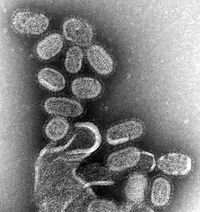
Photo from wikipedia
Influenza A (H7N9) is an emerging zoonotic pathogen with pandemic potential. To understand its adaptation capability, we examined the genetic changes and cellular responses following serial infections of A (H7N9)… Click to show full abstract
Influenza A (H7N9) is an emerging zoonotic pathogen with pandemic potential. To understand its adaptation capability, we examined the genetic changes and cellular responses following serial infections of A (H7N9) in primary human airway epithelial cells (hAECs). After 35 serial passages, six amino acid mutations were found, i.e. HA (R54G, T160A, Q226L, H3 numbering), NA (K289R, or K292R for N2 numbering), NP (V363V/I) and PB2 (L/R332R). The mutations in HA enabled A(H7N9) virus to bind with higher affinity (from 39.2% to 53.4%) to sialic acid α2,6-galactose (SAα2,6-Gal) linked receptors. A greater production of proinflammatory cytokines in hAECs was elicited at later passages together with earlier peaking at 24 hours post infection of IL-6, MIP-1α, and MCP-1 levels. Viral replication capacity in hAECs maintained at similar levels throughout the 35 passages. In conclusion, during the serial infections of hAECs by influenza A(H7N9) virus, enhanced binding of virion to cell receptors with subsequent stronger innate cell response were noted, but no enhancement of viral replication could be observed. This indicates the existence of possible evolutional hurdle for influenza A(H7N9) virus to transmit efficiently from human to human.
Journal Title: Scientific Reports
Year Published: 2017
Link to full text (if available)
Share on Social Media: Sign Up to like & get
recommendations!